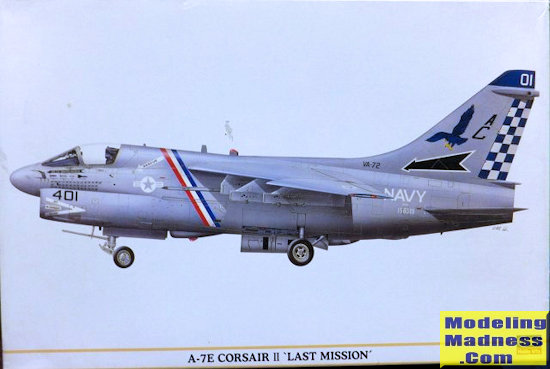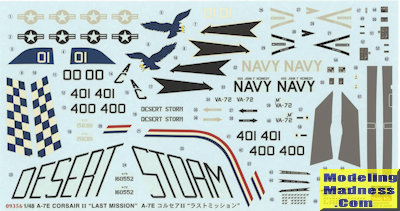Hasegawa 1/48 A-7E Corsair II 'Last Mission'
| KIT #: | 09356 |
| PRICE: | $15.00 from a vendor |
| DECALS: | Two options |
| REVIEWER: | Scott Van Aken |
| NOTES: | 2000 Limited Edition |

The Navy was sufficiently impressed with the increased power offered by the A-7D Spey engine used by the Air Force, and decided to use this engine for its own version of the Corsair II. The designation A-7E was assigned, and this version was to succeed the A-7B in production. However, there were delays in the deliveries of the TF41-A-2 engine specified for the A-7E, so the first 67 aircraft of the order were delivered with the TF30-P-5 engine. These aircraft had all of the other improvements planned for the A-7E, including the improved avionics and the M61 rotary cannon, and were re-designated A-7C after delivery.
The first Spey-powered A-7E flew for the first time on 9 March 1969. The A-7E differed from the USAF A-7D in retaining the probe-and-drogue midair refueling system of the earlier A-7A/B. It entered service in Southeast Asia in May 1970 with VA-146 and VA-147 deployed aboard the USS America. The A-7E participated in numerous close-air support missions over both North and South Vietnam, the A-7E's state-of-the-art bombing and navigation system being particularly reliable and accurate. Most air wings operating Douglas A-4 Skyhawks and early A-7s were re-equipped with A-7Es. The A-7E participated in the mining of Haiphong harbor in 1972, and played a vital role in Operations Linebacker I and Linebacker II that led up to the formal end of US involvement in the Vietnam War on 24 January 1973.
On 15 May 1975, A-7E aircraft operating from the USS Coral Sea, in conjunction with A-7D aircraft assigned to the 3d TFS at Korat RTAFB, provided air cover in what is considered the last battle of the Vietnam war, the recovery of the SS MayagŁez after it was hijacked by Khmer Rouge gunboats. By the time the Mayaguez incident was over, three USAF Sikorsky CH-53 Sea Stallion helicopters had been shot down, two airmen, 11 Marines and two Navy Corpsmen had been killed in action and a further three Marines were missing in action.
U.S. Navy A-7 Corsairs began being phased out of the fleet during the mid-1980s with the arrival of the McDonnell Douglas F/A-18 Hornet. Naval Reserve A-7 squadrons transitioned concurrent with (but prior to the completion of) all Regular Navy squadrons. The last Navy A-7s were retired by the last fleet operational squadrons (VA-46 and VA-72) in May 1991 shortly after their return from Operation Desert Storm. By the end of 1998, with the exception of some airframes used as static displays, all U.S. A-7s were disposed of by the AMARC at Davis-Monthan AFB, Arizona.
Some of these surplus aircraft were passed to Greece, Thailand and Portugal. The last Portuguese A-7Ps were retired in 2007 after 26 years. Greece retired its A-7s in 2014. The Corsair II served for 49 years.
 Hasegawa's A-7 series was initially released in 1987 and is still what many consider to be the best A-7 in this scale. The kit has been previewed several times, but not this particular boxing. The kit is currently released in its basic boxing as both an A-7D and A-7E, apparently included both sets of sprues as there are bits different between the two versions.
Hasegawa's A-7 series was initially released in 1987 and is still what many consider to be the best A-7 in this scale. The kit has been previewed several times, but not this particular boxing. The kit is currently released in its basic boxing as both an A-7D and A-7E, apparently included both sets of sprues as there are bits different between the two versions.
However, that is now and this kit is then when the D and E kits were boxed separately. The kit includes a fairly nice interior with an 8 piece bang seat. The seat is without harness detail as one is expected to install the pilot figure that is included. The kit provides two different seats actually and since the base instructions are for the initial boxing, you'll have to figure out which is appropriate for planes offered in this edition. Back to the cockpit there is a tub with separate side consoles a set of rudder pedals, a control stick and the appropriate instrument panel for the E version.
One will need to open several holes in the fuselage prior to installation of the cockpit and tail assembly. There is also a rather complete intake provided which contains the nose gear well. There will be a rather long seam that will be difficult to hide, though there have been aftermarket single cast intakes produced for this kit. A rather odd inclusion is a separate speed brake, which can be modeled deployed. Frankly, I've never seen this down on the ground as it is quite long. Those that build kits in flight would be the ones to take advantage of this feature.
Another feature are molded in avionics bays with their separate doors. One of these doors is for the RAT (ram air turbine). While having these doors open seems to be a rather regular occurrence in the USAF, one rarely saw this done in the Navy where issues of salt air are a concern. Cutting away the door hinges will allow those to be closed.
The kit's wings are molded with a number of features. One is that you can build the kit with the wings folded. Those who like folded wing models and who also may want a bit more shelf space will like this feature. Another is that the flaps and slats can be modeled deployed. Again, this was not often seen on the ground, but the option is there and I know many who will appreciate this.
Landing gearis well done and the kit seems to have the proper USN wheels. Something different from the USAF variant is the launch bar and its piston. Before assembling the wings, one needs to open the holes for the pylons. I have to tell you that it was quite normal for all six to be attached to the plane, even if it wasn't carrying anything. For stuff to hang on the plane you have a pair of fuselage Sidewinders (again, these were something rarely carried), a pair of fuel tanks, a pair of MERs (Multiple Ejection Racks) and the large FLIR (Forward looking infrared) pod. I found it interesting that the instructions would have you mount the large fuel tanks on the outer pylons. I'm not sure if those were even plumbed for fuel, but these were usually carried on the inboard pylons. If you want bombs and such, you'll have to get one of Hasegawa's weapons sets. Fortunately, the pylons include the anti-sway braces. I should also mention that there are a pair of photo-etch backings for the external cable runs.
 Instructions are typical Hasegawa with Gunze paint references. Markings are for one of the two final USN A-7Esquadrons that participated in Desert Storm, VA-72. One is the squadron commander's plane with some color in the tail and that is the one shown on the box art. The other is the specially painted 'Desert Storm' plane that was tricked out after the war in two browns. The decal sheet contains the fuselage and tailplane walk areas as well as lots of stencils. They are also old school Hasegawa decals where the whites are more of an ivory and they are a bit thick. Fortunately, there is no lack of A-7E decals in this scale
Instructions are typical Hasegawa with Gunze paint references. Markings are for one of the two final USN A-7Esquadrons that participated in Desert Storm, VA-72. One is the squadron commander's plane with some color in the tail and that is the one shown on the box art. The other is the specially painted 'Desert Storm' plane that was tricked out after the war in two browns. The decal sheet contains the fuselage and tailplane walk areas as well as lots of stencils. They are also old school Hasegawa decals where the whites are more of an ivory and they are a bit thick. Fortunately, there is no lack of A-7E decals in this scale
Because Hobby Boss boneheaded the intake and windscreen on their much newer A-7 kits in this scale (probably due to copying the inaccurate Monogram A-7A which was a worked over Aurora kit), the Hasegawa series of A-7D/E kits is still the best one out there. It is not difficult to find and well worth building.
https://en.wikipedia.org/wiki/LTV_A-7_Corsair_II
February 2016
Copyright ModelingMadness.com If you would like your product reviewed fairly and fairly quickly, please contact the editor or see other details in the Note toContributors.
Back to the Main Page
Back to the Previews Index Page



 Instructions are typical Hasegawa with Gunze paint references. Markings are for one of the two final USN A-7E
Instructions are typical Hasegawa with Gunze paint references. Markings are for one of the two final USN A-7E